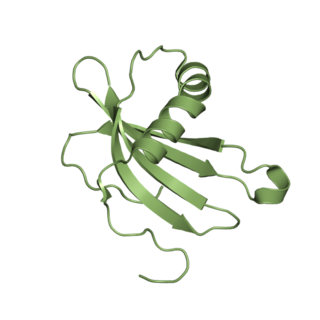In biology and biochemistry, protease inhibitors, or antiproteases, are molecules that inhibit the function of proteases. Many naturally occurring protease inhibitors are proteins.

Cathepsins are proteases found in all animals as well as other organisms. There are approximately a dozen members of this family, which are distinguished by their structure, catalytic mechanism, and which proteins they cleave. Most of the members become activated at the low pH found in lysosomes. Thus, the activity of this family lies almost entirely within those organelles. There are, however, exceptions such as cathepsin K, which works extracellularly after secretion by osteoclasts in bone resorption. Cathepsins have a vital role in mammalian cellular turnover.
Cathepsin L is a cysteine cathepsin, a lysosomal cysteine protease enzyme with endopeptidase activity which is involved in the initiation of protein degradation. It is a member of the Peptidase C1 (cathepsin) family, which play an important role in diverse processes including normal lysosome mediated protein turnover, antigen and proprotein processing, and apoptosis.

Cathepsin S is a protein that in humans is encoded by the CTSS gene. Transcript variants utilizing alternative polyadenylation signals exist for this gene.

Cathepsin O is an enzyme that in humans is encoded by the CTSO gene.

Cathepsin K, abbreviated CTSK, is an enzyme that in humans is encoded by the CTSK gene.

Cathepsin B belongs to a family of lysosomal cysteine proteases known as the cysteine cathepsins and plays an important role in intracellular proteolysis. In humans, cathepsin B is encoded by the CTSB gene. Cathepsin B is upregulated in certain cancers, in pre-malignant lesions, and in various other pathological conditions.
Fruit bromelain is an enzyme. This enzyme catalyses the following chemical reaction

Cathepsin L1 is a protein that in humans is encoded by the CTSL1 gene.

Cystatin-A is a protein that in humans is encoded by the CSTA gene.

Cystatin-B is a protein that in humans is encoded by the CSTB gene.

Cathepsin E is an enzyme that in humans is encoded by the CTSE gene. The enzyme is also known as slow-moving proteinase, erythrocyte membrane aspartic proteinase, SMP, EMAP, non-pepsin proteinase, cathepsin D-like acid proteinase, cathepsin E-like acid proteinase, cathepsin D-type proteinase) is an enzyme.

Cathepsin H is a protein that in humans is encoded by the CTSH gene.

Cathepsin Z, also called cathepsin X or cathepsin P, is a protein that in humans is encoded by the CTSZ gene. It is a member of the cysteine cathepsin family of cysteine proteases, which has 11 members. As one of the 11 cathepsins, cathepsin Z contains distinctive features from others. Cathepsin Z has been reported involved in cancer malignancy and inflammation.

Cathepsin L2, also known as cathepsin V and encoded by the CTSV gene, is a human gene.

Cathepsin W is a protein that in humans is encoded by the CTSW gene.

Cathepsin F is a protein that in humans is encoded by the CTSF gene.
Cathepsin X is an enzyme. This enzyme catalyses the following chemical reaction
Histolysin is an enzyme. This enzyme catalyses the following chemical reaction
Gingipain R is an enzyme. This enzyme catalyses the following chemical reaction:












